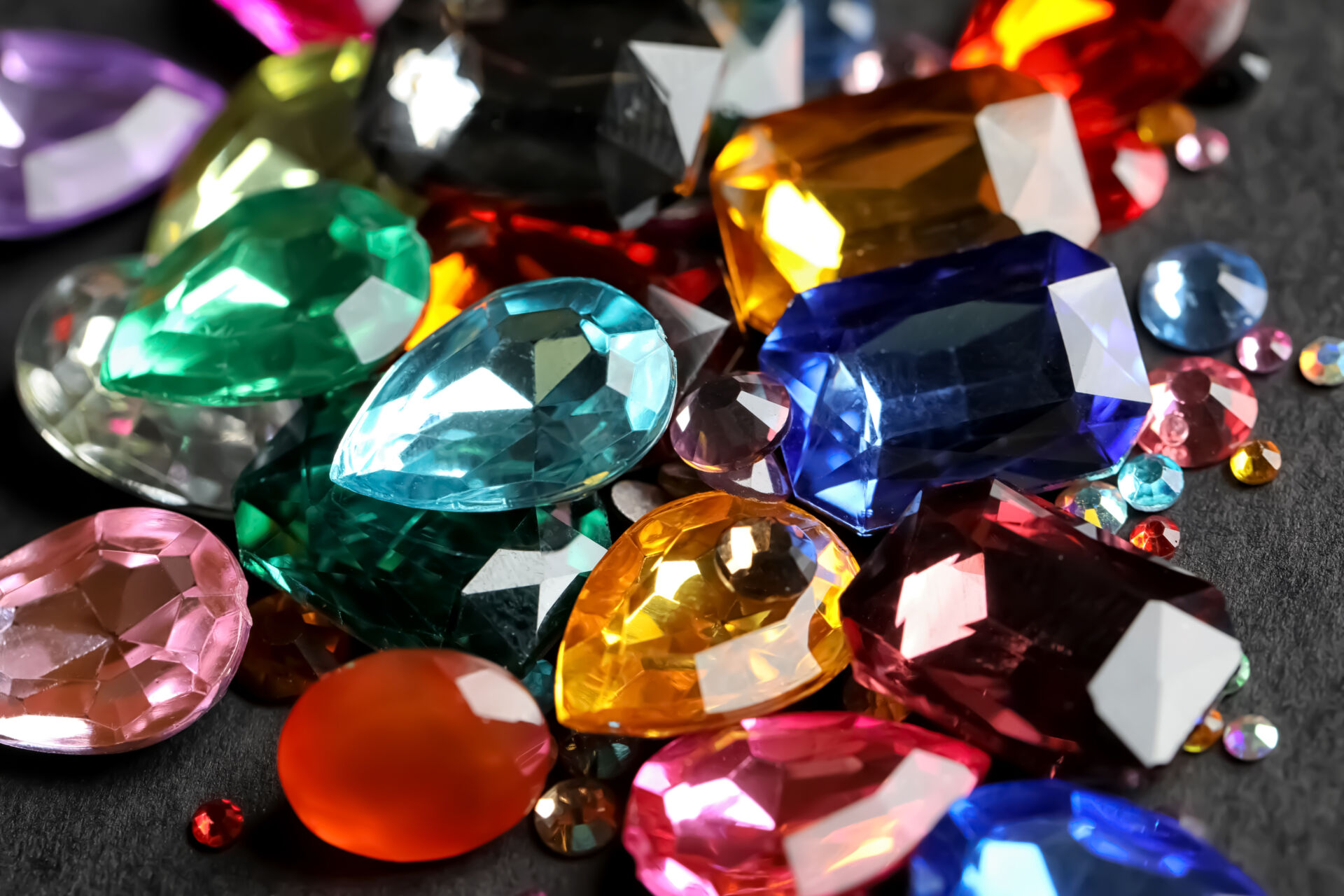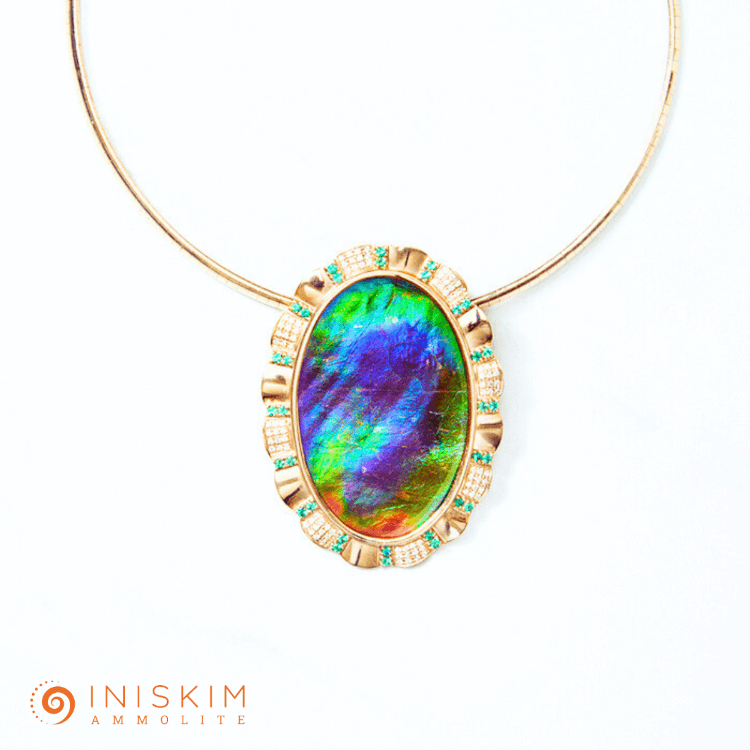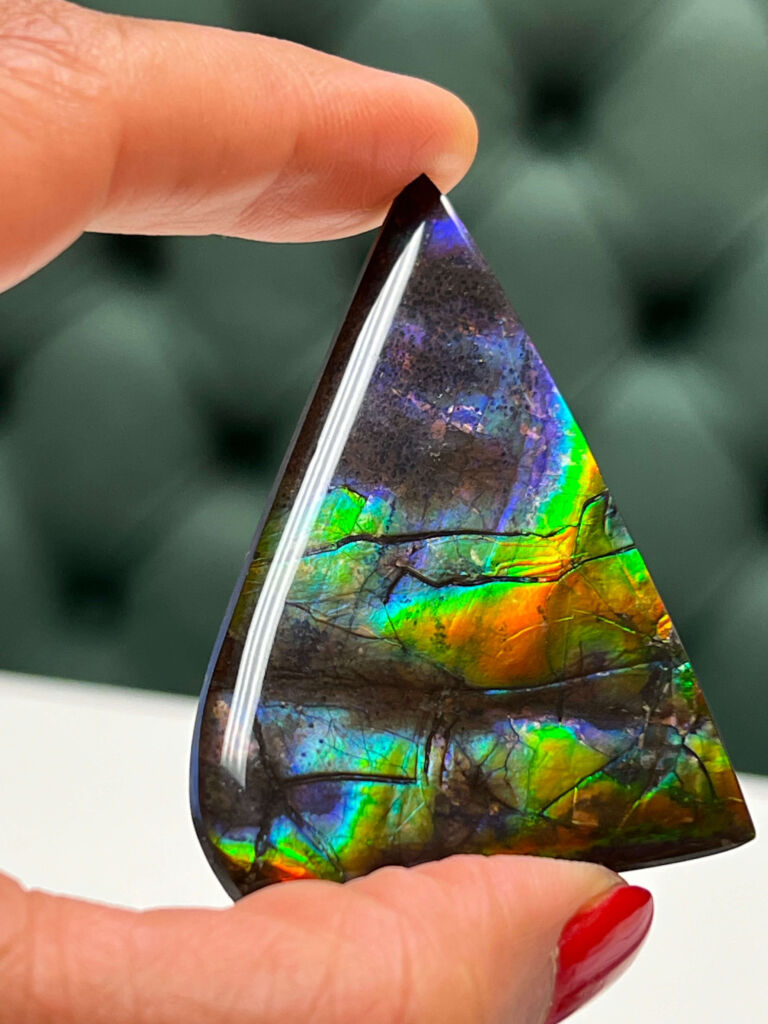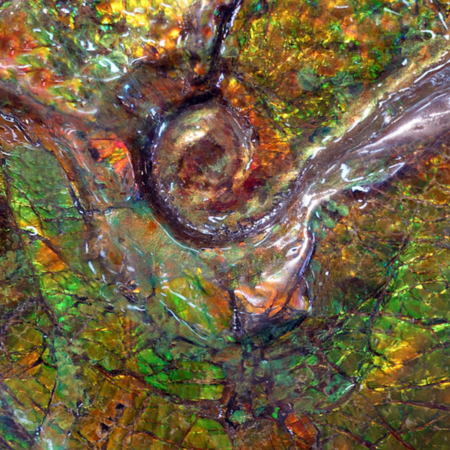
Imagine cradling a gemstone that not only mirrors the vibrant hues of a sunset but also holds the whispers of prehistoric oceans and the allure of Earth’s rarest treasures—all in one mesmerizing piece. This is Ammolite, a gem like no other, found exclusively in Alberta, Canada. It captivates with its stunning colours and embodies a rich tapestry of natural history and rarity.
Join us on a journey into the world of Ammolite, where we’ll explore how this extraordinary gem compares to other beloved gemstones like opal, emerald, sapphire, tourmaline, pearl, and moonstone. Discover the unique qualities that set Ammolite apart, making it a truly remarkable and alluring choice for gem enthusiasts and collectors alike. Whether it’s the gem’s dazzling colours or its ancient origins, Ammolite offers a fascinating blend of natural beauty and rarity that you won’t find anywhere else.
The Unique Charm of Ammolite
Beyond its stunning visual properties, Ammolite holds cultural and metaphysical significance. Indigenous peoples of North America have revered Ammolite as a powerful talisman, believing it to bring good luck and prosperity. This rich heritage, combined with its natural beauty, makes Ammolite not just a gemstone, but a piece of history and a symbol of natural wonder.
Geological Makeup and Mineralogy of Ammolite
Ammolite is an organic gemstone derived from the fossilized shells of Ammonites, primarily composed of aragonite. The aragonite crystals in Ammolite are arranged in layers, and the interference of light on these layers produces its vivid iridescence.
Unveiling the Hidden Advantages of Ammolite

Ammolite is incomparable with its array of patterns and colours.
Choosing Ammolite over other coloured gemstones offers several unique advantages:
- A gemstone with healing properties: Ammolite is often associated with Feng Shui, believed to enhance the flow of energy and bring prosperity, wisdom, and health. Its vibrant colours are thought to stimulate creativity and enhance overall well-being.
- Limited availability, high appreciation potential: The rarity of Ammolite contributes to its potential as a valuable investment. As the availability of high-quality Ammolite decreases, its value is expected to increase, making it a wise choice for collectors and investors alike.
- A piece of natural history: Each Ammolite gemstone is a snapshot of prehistoric marine life. The intricate patterns and colours are unique to each piece, telling a story that spans millions of years. This connection to ancient life adds a layer of intrigue and wonder that few other gemstones can offer.
- Versatility in jewellery design: Ammolite’s vibrant colours and unique patterns make it incredibly versatile for various jewellery designs. Whether set in a modern or classic style, Ammolite’s natural beauty enhances any piece, making it a favorite among designers and jewellers.
- Environmental stewardship: At Iniskim, we are committed to sustainable and ethical practices. Our sourcing methods ensure minimal environmental impact, and we work closely with trusted partners to promote sustainability, transparency, conservation and cultural respect.
Comparison to Popular Gemstones
The Optical Dance: Opal
Ammolite and opal are often compared due to their dazzling play of colours, but their differences are profound. Opals exhibit flashes of various hues as light interacts with the silica spheres within the stone, creating a stunning array of colours that shift and dance with movement.
Geological Makeup and Mineralogy of Opal:
Opal is primarily composed of silicon dioxide and water, forming in sedimentary rocks, often in areas with high geothermal activity. The microscopic silica spheres arranged in a regular pattern within the opal cause the diffraction of light, resulting in its characteristic play of colours.
In contrast, Ammolite’s vibrant colours stem from the microscopic structure of the fossilized shells of ammonites. This structure causes interference with light waves, producing a brilliant spectrum of colours that can include red, orange, green, blue, and even purple. Unlike opals, Ammolite’s colours are vivid and uniformly distributed across the surface, giving it a unique and mesmerizing appearance.
We sat down with a dear friend and colleague Sally Patel of True Blue Opals to find out more about her personal journey and changing the landscape of the Opal industry. As a strong female entrepreneur, it was a privilege to hear her first-hand experience. Click the link and keep reading to learn more.
A Symphony of Colors: Emerald
Emeralds have long been cherished for their deep, rich green hue, symbolizing renewal and growth. The allure of emerald lies in its intense colour and the way it captures light, creating a lush, verdant glow. However, emeralds typically display a single dominant colour, which, while striking, lacks the multicoloured brilliance found in Ammolite.
Geological Makeup and Mineralogy of Emerald:
Emerald is a variety of the mineral beryl, coloured green by trace amounts of chromium and sometimes vanadium. Emeralds form in hydrothermal veins and metamorphic rocks, often found in Colombia, Brazil, and Zambia. Their colour and clarity are highly valued, although inclusions are common and can affect their transparency.

Make a statement by combining popular gemstones with lesser-known gems like Ammolite.
Rarity and Origin: Sapphire
Sapphires, especially the prized blue varieties, are celebrated for their clarity, durability, and the depth of their colour. These gemstones are found in various locations worldwide, including Sri Lanka, Madagascar, and Australia, making them relatively more accessible compared to Ammolite.
Geological Makeup and Mineralogy of Sapphire:
Sapphire is a variety of the mineral corundum, composed of aluminum oxide. The presence of trace elements like iron, titanium, and chromium gives sapphires their range of colours, though blue is the most famous. Sapphires are formed in igneous and metamorphic rocks and are renowned for their hardness, second only to diamonds.
The Unique Allure: Tourmaline
Tourmaline is known for its impressive range of colours, often occurring in multi-coloured forms such as watermelon tourmaline, which displays green, pink, and white zones. While tourmaline’s colour diversity is notable, Ammolite’s iridescence offers a different kind of visual spectacle, with its dynamic play of colours that change with the angle of light.
Geological Makeup and Mineralogy of Tourmaline:
Tourmaline is a boron silicate mineral that includes elements such as aluminum, iron, magnesium, sodium, lithium, or potassium. This complex composition results in a wide variety of colours. Tourmaline forms in igneous and metamorphic rocks and is found in countries like Brazil, Afghanistan, and the United States.
Iridescent Beauty: Moonstone
Moonstone is cherished for its adularescence, a soft, billowy light that seems to float beneath its surface. This optical effect, caused by the interaction of light with the internal micro-structures of the stone, is distinct from Ammolite’s vivid and broad-spectrum iridescence.
Geological Makeup and Mineralogy of Moonstone:
Moonstone is a variety of the mineral feldspar, composed of potassium aluminum silicate. Its shimmering glow is created by the interplay of two distinct types of feldspar with varying refractive properties. Moonstone is commonly sourced from Sri Lanka, India, and Myanmar.
Chameleon-like Charm: Alexandrite
Alexandrite is renowned for its remarkable color-changing ability, shifting from green in daylight to red under incandescent light. This unique optical phenomenon, known as the “alexandrite effect,” makes it one of the most fascinating and sought-after gemstones.
Geological Makeup and Mineralogy of Alexandrite:
Alexandrite is a variety of chrysoberyl, composed primarily of beryllium aluminum oxide with trace amounts of chromium, which is responsible for its color-changing properties. Alexandrite forms in metamorphic rocks and is predominantly found in Russia, Brazil, and Sri Lanka.
While both Ammolite and Alexandrite captivate with their unique optical phenomena, their visual effects differ significantly. Alexandrite’s dramatic color change is due to the chromium impurities within the crystal structure, while Ammolite’s vibrant and shifting colors arise from the interference of light on the layered aragonite structure of fossilized ammonite shells. Ammolite’s broad spectrum of iridescent hues can present multiple colors simultaneously, offering a different kind of visual spectacle compared to Alexandrite’s distinct color shift.
Natural Elegance: Pearl
Pearls are unique among gemstones as they are organic and produced by living organisms—oysters and other mollusks. While pearls exude a classic, understated elegance with their lustrous, silky surface, Ammolite offers a striking and vibrant colour display, making each piece an eye-catching work of art. Ammolite is also one of the few gemstones that is organic, derived from the fossilized shells of ancient marine creatures.
Geological Makeup and Mineralogy of Pearl:
Pearls are composed of calcium carbonate (mainly aragonite) in a conchiolin matrix. They form in the soft tissue of mollusks as a response to an irritant, which is coated in layers of nacre over time. Pearls are harvested from both freshwater and saltwater sources around the world.

There are only a handful of iridescent gemstones in the world, including Ammolite. The colour spectrum for Ammolite is incredibly rare.
Why Choose Ammolite Over Other Coloured Gemstones?
Choosing Ammolite over other coloured gemstones offers several unique advantages:
- Exclusivity and rarity: Ammolite is one of the rarest gemstones in the world, found only in a single location in the world. Its limited supply ensures that each piece is a unique and precious treasure.
- Vivid and unique colour spectrum: Unlike other gemstones that typically display a single colour or a subtle play of colours, Ammolite can exhibit a full spectrum of brilliant hues in one piece, making it visually captivating.
- Historical and geological significance: Owning an Ammolite gemstone means possessing a piece of prehistoric life. The fossilized remains of ancient ammonites carry a rich history dating back 71-million-years, adding depth and meaning to its beauty.
- Cultural heritage: Ammolite holds significant cultural value, particularly among the Blackfoot Tribe of North America, as a sacred stone (Buffalo stone). It is believed to bring good luck, prosperity, and positive energy, making it more than just a gemstone but a symbol of well-being and tradition. The stone’s iridescent colors are thought to embody the spirit of the buffalo, which is a central and sacred figure in Blackfoot culture.
- Ethical and sustainable sourcing: At Iniskim, we are committed to ethical and responsible sourcing. Each Ammolite gemstone is obtained sustainably, ensuring that the natural environment and local communities are respected and preserved.
Interested in seeing more Ammolite and Ammonite product? We recently launched a digital WhatsApp catalog to showcase the latest additions to our collection available for purchase. Get in touch with Amarjeet to learn more.
Conclusion
While opal, emerald, sapphire, tourmaline, moonstone, and pearl each have their own unique qualities and charm, Ammolite stands out due to its rare origin, vibrant colour spectrum, and deep historical significance. Choosing Ammolite means not only owning a piece of stunning natural beauty but also embracing a gemstone with a rich cultural heritage and a commitment to ethical and sustainable practices. Discover the unparalleled allure of Ammolite with Iniskim, and add a truly unique and captivating piece to your gemstone collection.


